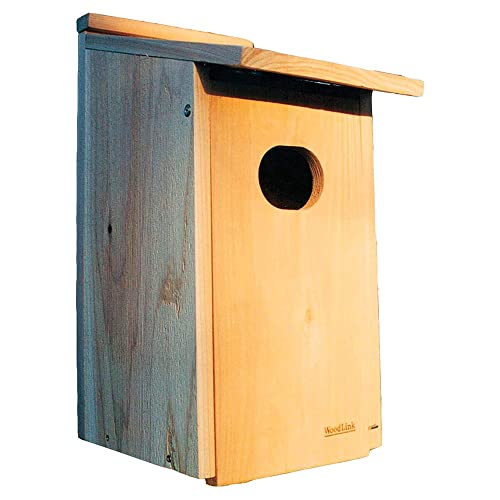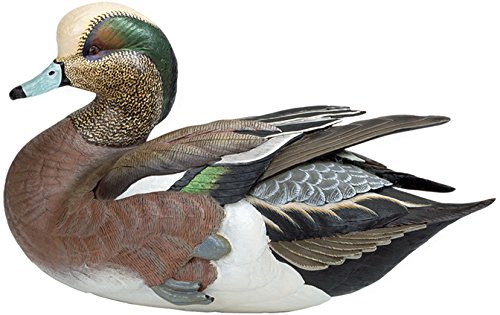
Waterfowl compose an important part of many aquatic ecosystems around the world, and includes three different families: Anhimidae, Anseranatidae, and Anatidae. The most commonly known family is Anatidae, which includes approximately 147 different species of ducks, swans, and geese that can be found worldwide. Within the family of Anhimidae includes only three species, known as screamers, which are a type of large South American bird that are most well-known for the loud, strident screams that they emit when they feel threatened. Anseranatidae is comprised of only a single species – the magpie goose, found only in Australia and portions of New Guinea.
For almost all pond owners, the only family of waterfowl you’ll be able (or want) to attract will be within the largest anatide family. This family includes all the most common duck species, including the iconic mallard, the extravagant mandarin, and the mysterious wood duck.
5 Ways to Attract Wild Ducks To Ponds
If you have a pond or a garden, ducks are well-known for contentedly eating nuisance slugs, tomato worms, Japanese beetles (an invasive species, anyway!) while finding garden fruits and vegetables to be largely unpalatable compared to insects. In ponds, many ducks will happily eat various fly species, aquatic insects such as water beetles, clams and snails that could get into your filters, and insect larvae among other things. Fancy having some ducks in your pond, garden, or lake? Below are a few methods to make your space more attractive:-
1) Keep Water Accessible (And Open)
- Aeration for 2,000 - 8,000-gallon ponds and water gardens
- Max operating depth is 4 feet deep
- Provides 0.80 CFM airflow with 1 Dual Stick Plate
Many common duck species, such as mallards, wood ducks, and shovelers prefer shallower water that is a few feet or less in depth. Make sure that your pond or lake has sides that gradually slope as opposed to being steep, for easier exit and entry for ducks. Shallow banks will also better enable aquatic and marginal plants to grow easily, which in turn will attract ducks. Having both shallow areas and a portion of your pond that is six or more feet in depth will bring in dabbling and diving ducks, respectively, and increase your odds of attracting ducks overall.
To keep non-migratory ducks around for the winter, incorporate a high-powered aeration system into your pond or a portion of the lake. This will create some turbulence that will help keep the water in that area moving and ice-free for ducks to drink and browse for any food items that may still be present.
2) Add Aquatic Plants
Plants provide food (for some duck species) as well as cover to protect themselves and their nests from inclement weather and potential predators. Make sure that your pond or lake contains a variety of both aquatic and terrestrial plants, to provide plenty of cover on both water and land. Some ducks, such as redheads and canvasbacks, nest upon floating vegetation on the water. Others, like teals and pintails, prefer to nest on the ground with some form of vegetation surrounding them (brushy plants and tall grasses, for example). You should first figure out which plants are native to your area, so that you don’t include any that may be invasive or otherwise problematic. Often, a good mix of both floating plants, such as water lilies, and marginal plants, such as cattails and grasses, works best to provide ducks both shelter and protection.
3) Create Nesting Sites (Duck Boxes)
- Woodlink ornithologically designed wood duck nesting box for wetland locations
- Handcrafted construction of re-forested, kiln dried, inland red cedar with chromate screws
- Features a 4 inch by 3 inch oval hole and easy open front
Ducks will not settle in an area that doesn’t have suitable nesting options. As mentioned previously, vegetation will be enough to entice some ducks. Others, though, require slightly more sophisticated digs. For example, wood ducks, mergansers (except the red-breasted merganser), goldeneyes, buffleheads, and many others prefer to nest in cavities off of the ground. If you have large trees on your property with existing cavities – perfect! If not, you can either build or purchase specific duck boxes and place them on trees or poles five feet or more above the ground. Be sure to space them 100 feet or more apart from one another. In addition, make absolutely certain that the box is made of untreated wood, as many treatments are toxic to birds and can cause serious health issues, birth defects, or even death. Some ducks will also utilize hollow logs, or conversely you could take a solid log and create an opening in it by hand.
4) Deter Natural Predators
- SOLAR POWERED: No batteries or power cords required; Movement is powered by the sun’s energy and collected through a solar panel on top...
- INCREDIBLY REALISTIC: Our patented Natural Enemy Scarecrow Owl is extremely lifelike. Carefully painted, so every detail mimics the...
- DYNAMIC MOVEMENT: With a 360° range of motion, the Owl’s head bobs and turns, keeping unwanted wildlife on alert and frightening them...
If there are too many predators in the area, such as foxes, raccoons, fishers, and cats, it can deter ducks from sticking around for too long. To combat this, you can utilize deterrents such as scent sprays, fencing, live trapping, and owl decoys. Furthermore, be sure to keep your pets indoors as much as possible, or at least in an area or on a leash away from the desired duck habitat. If you’re utilizing nest boxes, try placing them on a metal or wooden pole with a cone guard below the box that will prevent most predators from being able to climb to the box.
When choosing a deterrent method, we recommend not using sound or water based deterrents as these will also scare ducks away. If you’re selecting decoys, owl decoys will work best to deter small predators and make ducks feel safer in their environment. Using larger decoys, such as coyotes, which would naturally prey on waterfowl, will make ducks more nervous and less likely to land, so should be avoided.
5) Use Wild Duck Decoys
- 6538505506 Weaver Bottoms American Widgeon Large Decoy
- Noted artist and avid conservationist, Sam Nottleman's meticulous attention to detail and accurate knowledge of waterfowl is clearly evident...
- Each is beautifully replicated in these sculptures; perfectly proportioned for desktop or shelf
Ducks are rather visual creatures, and tend to follow their peers. Placing a decoy duck pair in the water will make it seem more attractive to ducks passing by, or at the very least pique their curiosity enough that they’ll check it out since they think that other ducks are there. If you have enough of the above requisites, they’ll likely stay for a longer period once they become comfortable in their new environment.
The more duck decoys you can add to your pond, the more chance you’ll have to attract ducks, as almost all species of waterfowl will feel safer in larger numbers. One of the best tactics would be to place a few floating decoys in the water, and some relaxed decoys resting on the banks, which shows that all areas of the pond are safe for birds!
Different Types of Wild Ducks (Dabblers & Divers)

Within the Anatidae family is the genus Anatinae, containing only ducks. Some of the most familiar species within this family that are native to the United States are the wood duck, mallard, America widgeon, northern pintail, scaups (both lesser and greater), blue-winged teal, and many others. Ducks are separated even further into two main groups: dabbling ducks and diving ducks.
Dabbling ducks have adapted to feed in shallow water, where they “dabble” in the water and mud with their bills for insects, macro-invertebrates, and vegetation. They have small feet that are placed more closely together to enable greater ease of movement on land and in shallow water.
Diving ducks are fairly self-explanatory, and have evolved to be able to dive into water to feed upon the bottom of the water body or chase moving fare under the water’s surface. Their feet are larger and located farther back on their body than that of dabbling ducks, making it much easier for divers to swim and navigate underwater.
When Will Ducks Arrive? How Do You Identify Them?

At which time ducks will arrive during the year, if they will show up at your water body at all, and how and where they nest depends entirely on the species. For example, wood ducks prefer wooded marshes, their year-round range includes the eastern and midwestern U.S. as well as portions of California, and they prefer to nest in trees with hollows or specially built nest boxes several meters above the ground to keep their young out of easy reach of predators. In winter, they stay in the western and southern U.S. as well as northern Mexico.
Northern shovelers like shallow wetlands and freshwater ponds, and spend their summers in Canada and the northern portions of the U.S., migrating through much of the rest of the U.S. and Mexico during fall and winter. They nest by simply scraping a small depression into the ground, usually near water in an area surrounded by vegetation to shelter them from predators and the elements.
If you’re looking to attract certain species (or figure out which ones are native to your area), your best bet is to check out a comprehensive, detail-packed website such as the Cornell Lab of Ornithology or Audubon to figure out their specific range and habitat requirements.
If you want something a bit more convenient, you can download the free Merlin Bird ID App to your phone or other device that will allow you to identify any bird species that you see anywhere in the world, listen to their calls, see photos, and look up information such as habitat requirements for virtually all bird species. It’s incredibly easy to use, and can be quite helpful.
Should You Attract Ducks To Fish Ponds? (Ducky Downsides)

Ducks are beneficial to lakes, natural ponds, and gardens, but could prove to be a nuisance or even harmful to garden ponds with fish stocks. Some duck species feed on fish, and diving ducks can stir up substrate that could cause damage to your fish and water quality. Aquatic plants may also sustain injury via browsing, and terrestrial plants via being trampled by ducks’ large, webbed feet.
In addition, defecation will contribute to waste that decreases water quality, and a smaller water body such as a garden pond will be less able to filter the waste, even with an added filtration system. Moreover, the waste will use up valuable dissolved oxygen and encourage algal growth. Ducks tend to move between water bodies, and are known to transfer bacteria and parasites from one to the next. This could spell trouble for any fish or other critters that you’ve stocked in your pond. With these things in mind, it is best to keep ducks away from fish ponds.






Great article! Thank you for the tips and information!
Hi Melissa,
Thanks for the comment! Glad to hear the information was helpful to you.
Where do mallards like to nest?
Hi Mila,
Mallards typically build their nests in thick vegetation like tall grasses or sedges, usually on dry land near water. Sometimes, if there’s a decently sized floating mat of vegetation, mallards will build their nests on those.
Most of my pond is covered in some time of vegetation including a large share in bulrushes. I wonder if this is a problem for ducks? We have had ducks inhabit the river on edge of our property.
Hi Rosemary,
Sorry about the late response! Ducks generally like a mix of open water for swimming and foraging, and vegetation for cover and nesting. The bulrushes along the edge are perfectly fine for them, but if you’re hoping to encourage them to come to your pond from the river, you might consider clearing a bit of the vegetation toward the middle of the pond so they have an appealing open area. Also make sure that at least a portion of one side of the pond is relatively clear of vegetation, to allow them a clear path for landing and takeoff. They’re social creatures, so adding in a fake duck or two might elicit enough curiosity that other ducks will come and explore.
A very useful article! I haven’t seen it anywhere better! Everything is well described, very informative!
Thanks, Clinton! We’re very happy to hear you found the article helpful and informative. Best of luck with your duck pond! 🦆